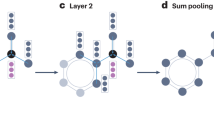Abstract
Several applications can be developed when graphs represent objects composed of local parts and their relations. For instance, chemical compounds are characterised by nodes that represent chemical elements and edges that represent bonds between them. Given this representation, applications such as drug discovery (graph generation), toxicity prediction (graph regression) or drug analysis (graph classification) can be developed. In all of these applications, it is crucial to properly define how similar are the local parts and how important are them in the application at hand. We present a method that learns these similarities of local parts of the objects and also how important are when objects are represented by attributed graphs and attributes on the graphs are categorical values. Although the method is independent of the application, we have empirically tested on drug classification obtaining competitive results.
Access this chapter
Tax calculation will be finalised at checkout
Purchases are for personal use only
Similar content being viewed by others
References
Algabli, S., Serratosa, F.: Embedding the node-to-node map**s to learn the graph edit distance parameters. Pattern Recogn. Lett. 112, 353–360 (2018)
Caetano, T.S., McAuley, J.J., Cheng, L., Le, Q.V., Smola, A.J.: Learning graph matching. IEEE Trans. Pattern Anal. Mach. Intell. 31(6), 1048–1058 (2009)
Cortés, X., Conte, D., Cardot, H.: Learning edit cost estimation models for graph edit distance. Pattern Recogn. Lett. 125, 256–263 (2019)
Cortés, X., Conte, D., Cardot, H., Serratosa, F.: A deep neural network architecture to estimate node assignment costs for the graph edit distance. In: Proceedings of Structural, Syntactic, and Statistical Pattern Recognition - Joint IAPR International Workshop, S+SSPR 2018, Bei**g, China, 17–19 August 2018, Vol. 4, pp. 326–336 (2018)
Garcia-Hernandez, C., Fernández, A., Serratosa, F.: Ligand-based virtual screening using graph edit distance as molecular similarity measure. J. Chem. Inf.. Model. 59 (2019)
Garcia-Hernandez, C., Fernández, A., Serratosa, F.: Learning the edit costs of graph edit distance applied to ligand-based virtual screening. Curr. Top. Med. Chem. 20(18), 1582–1592 (2020)
Gatica, E.A., Cavasotto, C.N.: Ligand and decoy sets for docking to g protein-coupled receptors. J. Chem. Inf. Model. 52(1), 1–6 (2011)
Harper, G., Bravi, G.S., Pickett, S.D., Hussain, J., Green, D.V.S.: The reduced graph descriptor in virtual screening and data-driven clustering of high-throughput screening data. J. Chem. Inf. Comput. Sci. 44(6), 2145–2156 (2004). https://doi.org/10.1021/ci049860f
Lagarde, N., et al.: NRLIST BDB, the manually curated nuclear receptors ligands and structures benchmarking database. J. Med. Chem. 57(7), 3117–3125 (2014)
Leordeanu, M., Sukthankar, R., Hebert, M.: Unsupervised learning for graph matching. Int. J. Comput. Vision 96(1), 28–45 (2012)
Martineau, M., Raveaux, R., Conte, D., Venturini, G.: Learning error-correcting graph matching with a multiclass neural network. Pattern Recogn. Lett. 134, 68–76 (2018)
Mysinger, M.M., Carchia, M., Irwin, J.J., Shoichet, B.K.: Directory of useful decoys, enhanced (dud-e): better ligands and decoys for better benchmarking. J. Med. Chem. 55(14), 6582–6594 (2012)
Neuhaus, M., Bunke, H.: Self-organizing maps for learning the edit costs in graph matching. IEEE Trans. Syst. Man Cybernet.. Part B (Cybernetics)35(3), 503–514 (2005)
Neuhaus, M., Bunke, H.: Automatic learning of cost functions for graph edit distance. Inf. Sci. 177(1), 239–247 (2007)
Rica, E., Álvarez, S., Serratosa, F.: On-line learning the graph edit distance costs. Pattern Recognit. Lett. 146, 55–62 (2021). https://doi.org/10.1016/j.patrec.2021.02.019, https://doi.org/10.1016/j.patrec.2021.02.019
Rohrer, S.G., Baumann, K.: Maximum unbiased validation (MUV) data sets for virtual screening based on PubChem bioactivity data. J. Chem. Inf. Model. 49(2), 169–184 (2009)
Sanders, M.P., et al.: Comparative analysis of pharmacophore screening tools. J. Chem. Inf. Model. 52(6), 1607–1620 (2012)
Santacruz, P., Serratosa, F.: Error-tolerant graph matching in linear computational cost using an initial small partial matching. Pattern Recogn. Lett. 134, 10–19 (2018)
Santacruz, P., Serratosa, F.: Learning the graph edit costs based on a learning model applied to sub-optimal graph matching. Neural Process. Lett. 51, 1–24 (2019)
Serratosa, F.: Fast computation of bipartite graph matching. Pattern Recogn. Lett. 45, 244–250 (2014)
Serratosa, F.: Redefining the graph edit distance. SN Comput. Sci. 2(6), 1–7 (2021)
Skoda, P., Hoksza, D.: Benchmarking platform for ligand-based virtual screening. In: Proceedings - 2016 IEEE International Conference on Bioinformatics and Biomedicine, BIBM 2016, pp. 1220–1227 (2017). https://doi.org/10.1109/BIBM.2016.7822693
**a, J., Tilahun, E.L., Reid, T.E., Zhang, L., Wang, X.S.: Benchmarking methods and data sets for ligand enrichment assessment in virtual screening. Methods 71, 146–157 (2015)
Acknowledgements
This project has received funding from Martí-Franquès Research Fellowship Programme of Universitat Rovira i Virgili.
Author information
Authors and Affiliations
Corresponding author
Editor information
Editors and Affiliations
Rights and permissions
Copyright information
© 2022 The Author(s), under exclusive license to Springer Nature Switzerland AG
About this paper
Cite this paper
Rica, E., Álvarez, S., Serratosa, F. (2022). Learning Distances Between Graph Nodes and Edges. In: Krzyzak, A., Suen, C.Y., Torsello, A., Nobile, N. (eds) Structural, Syntactic, and Statistical Pattern Recognition. S+SSPR 2022. Lecture Notes in Computer Science, vol 13813. Springer, Cham. https://doi.org/10.1007/978-3-031-23028-8_11
Download citation
DOI: https://doi.org/10.1007/978-3-031-23028-8_11
Published:
Publisher Name: Springer, Cham
Print ISBN: 978-3-031-23027-1
Online ISBN: 978-3-031-23028-8
eBook Packages: Computer ScienceComputer Science (R0)




